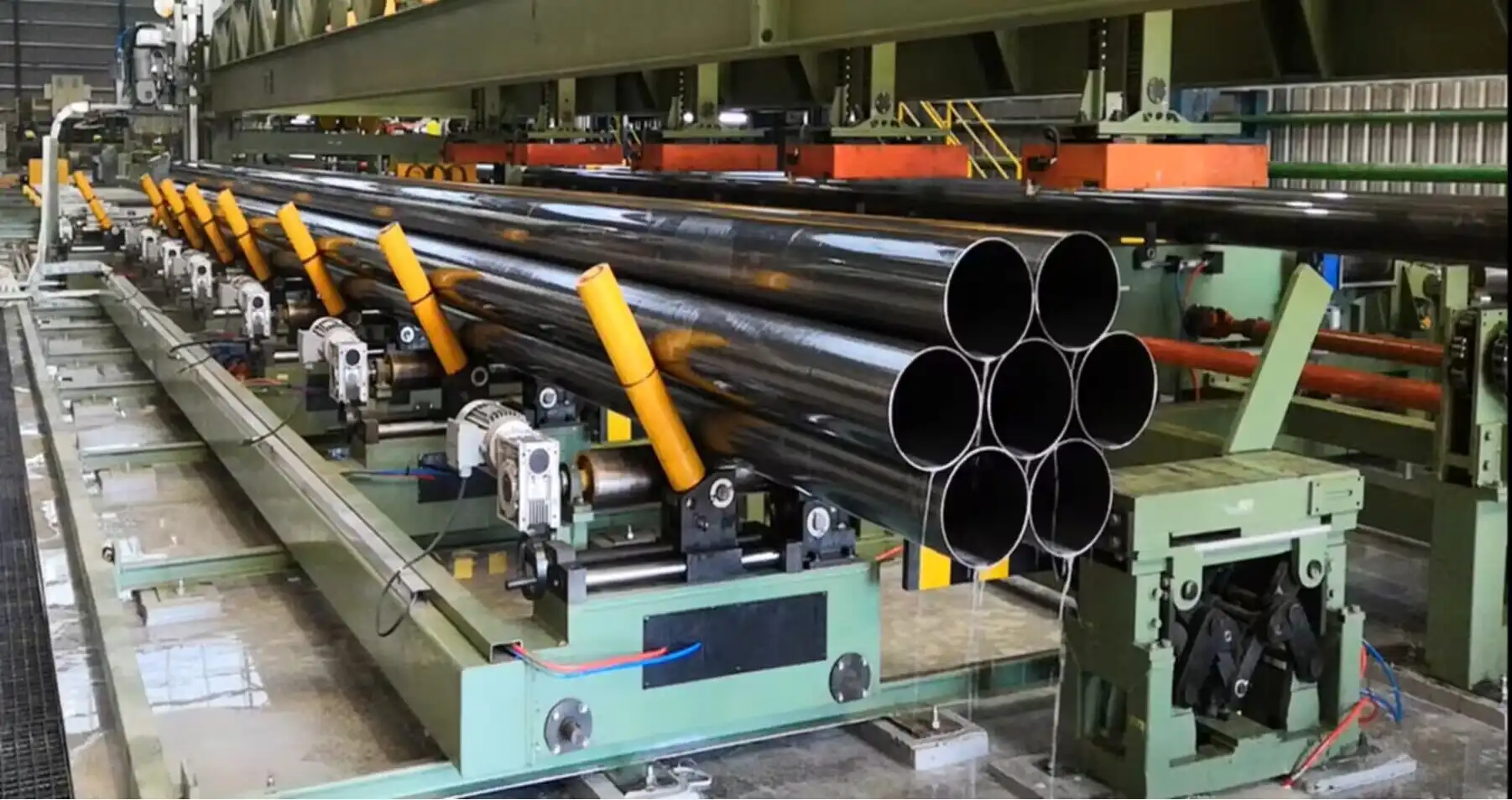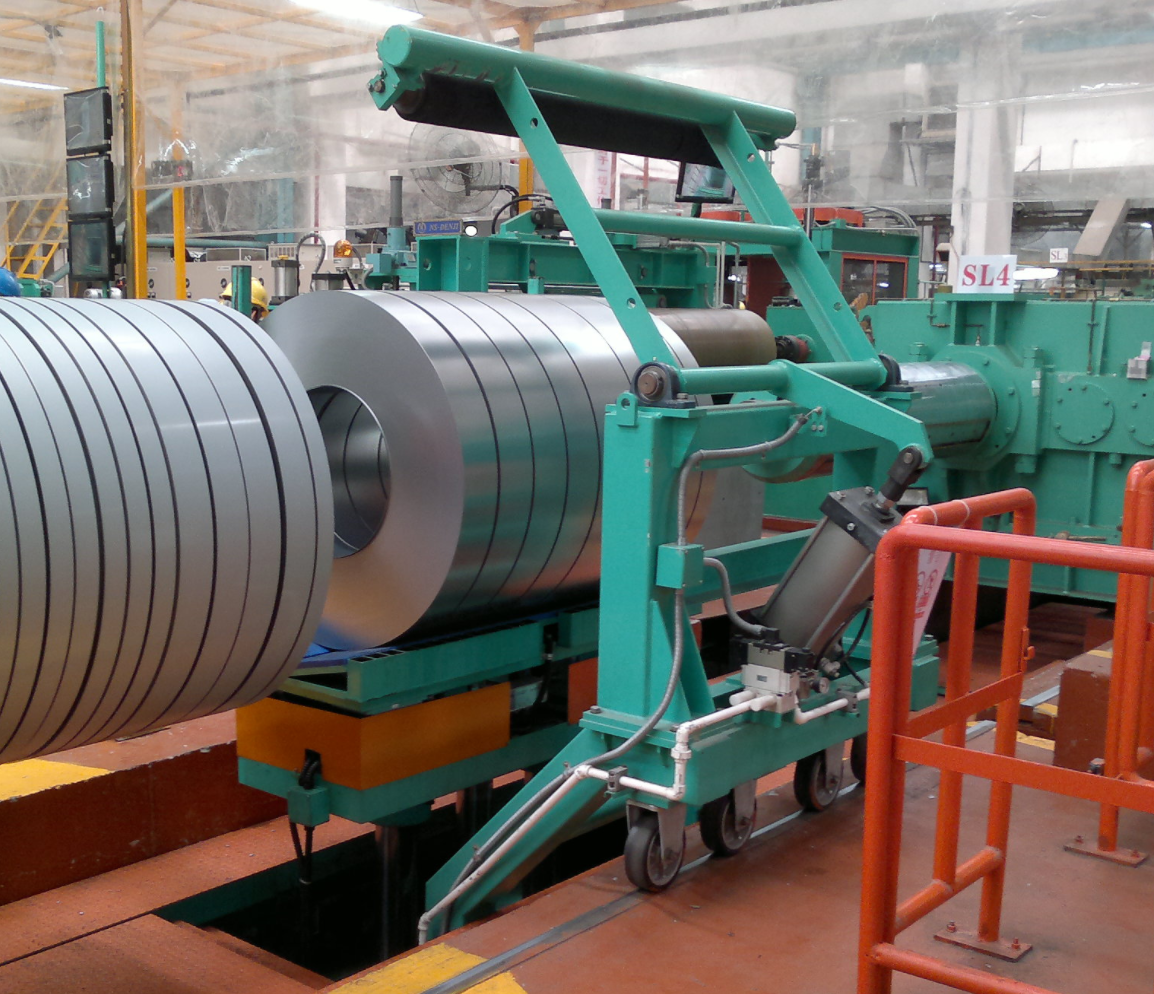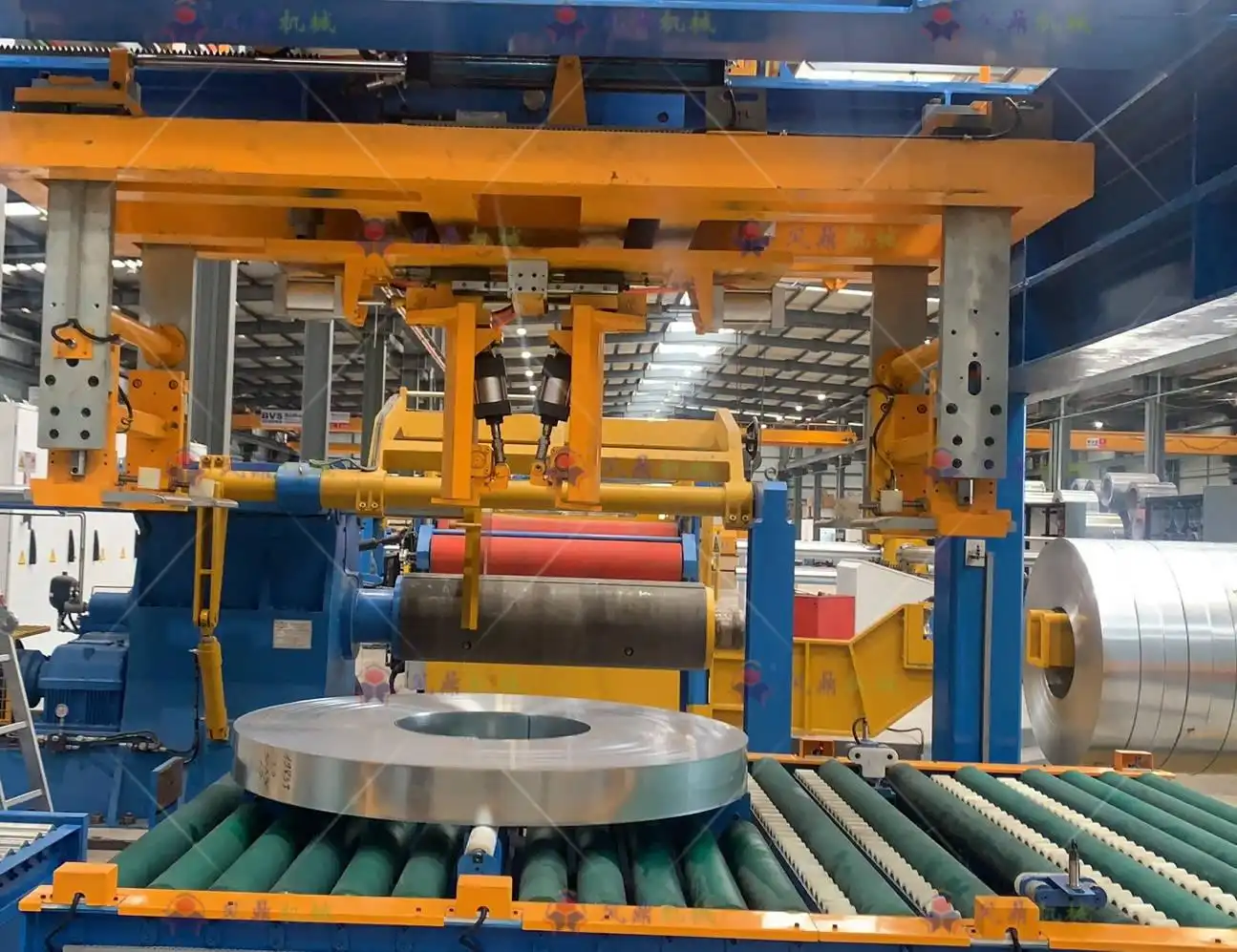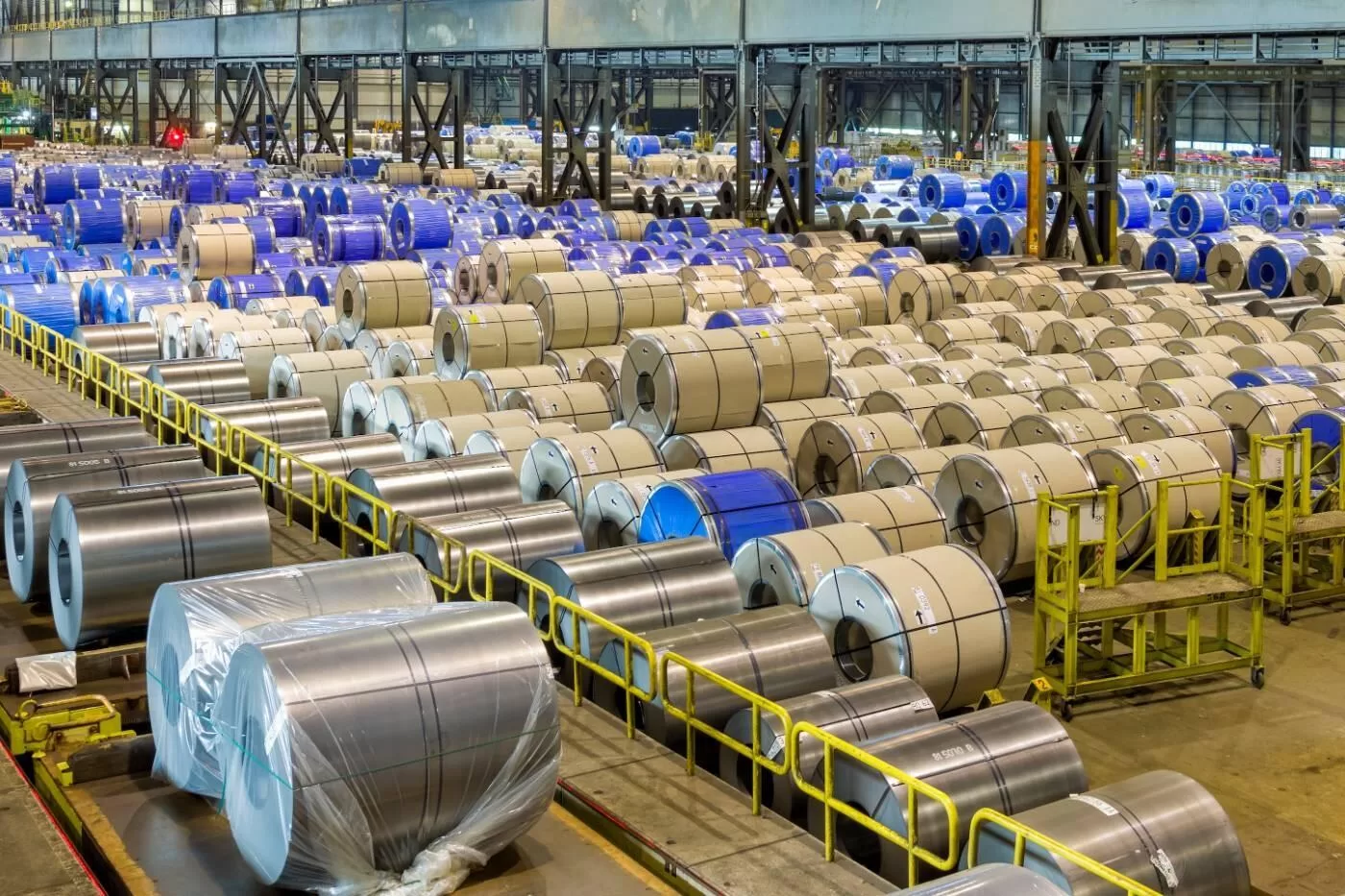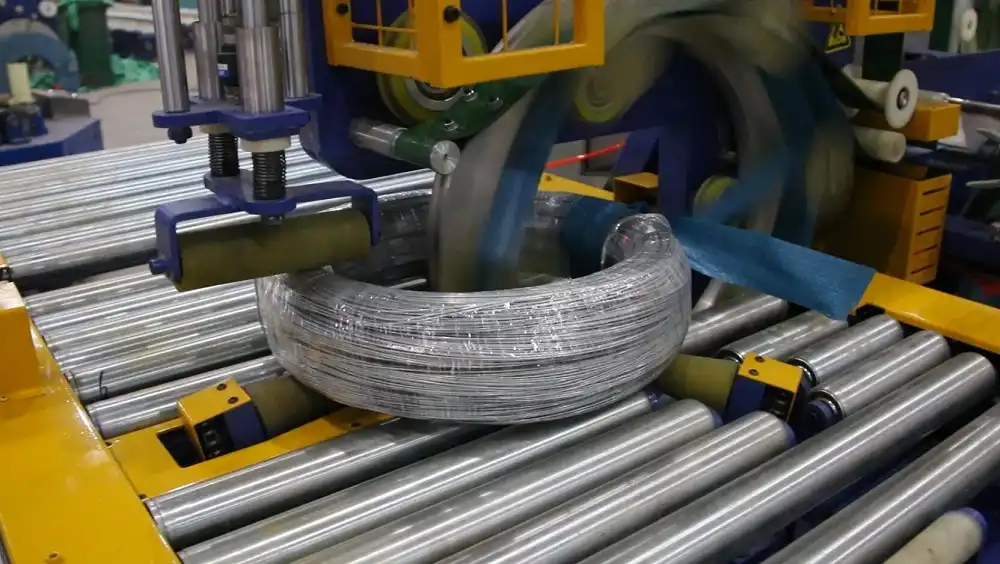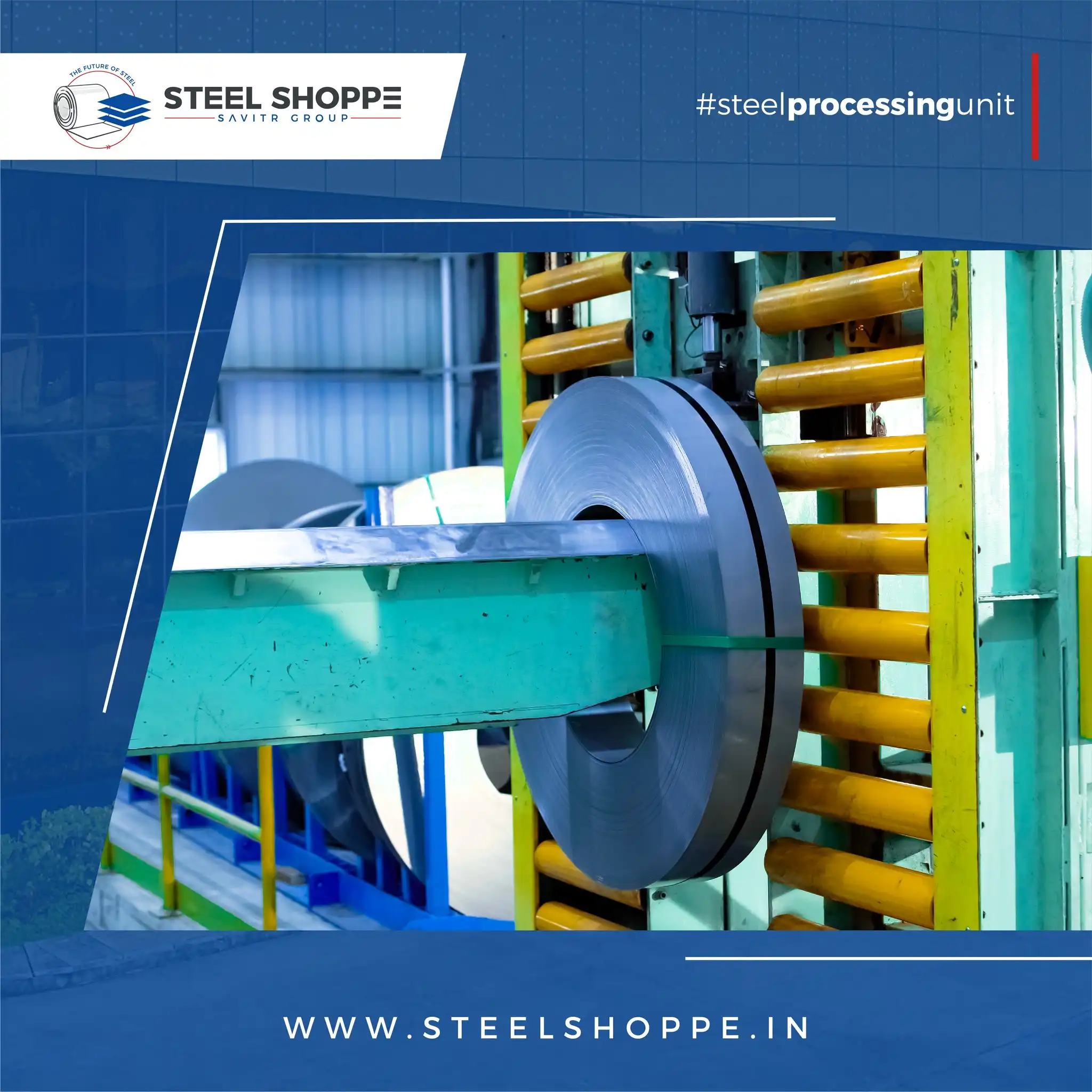A Strategic Guide to Single-Operator End-of-Line Automation: Integrating Palletizing, Strapping, Packing, and Warehousing
The Vision of the Single-Operator End-of-Line Ecosystem
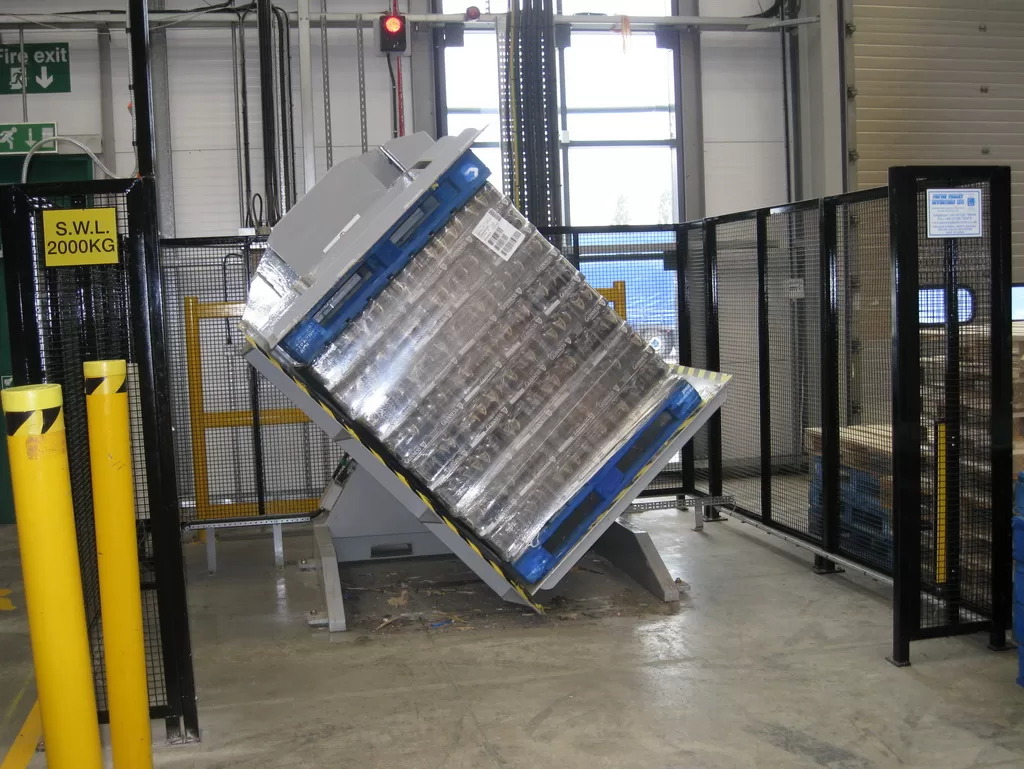
Introduction: From Manual Labor to Automated Orchestration
In the landscape of modern manufacturing and distribution, the final stages of the production line—often referred to as end-of-line (EoL) packaging—have traditionally represented a significant concentration of manual labor. These stages, encompassing the palletizing of finished goods, the securing of those loads with strapping and wrapping, and their subsequent transfer to warehousing, are characterized by repetitive, physically demanding, and ergonomically hazardous tasks. A typical EoL operation involves multiple operators performing siloed functions: one or more stacking boxes, another operating a strapping machine, a third managing a stretch wrapper, and forklift drivers transporting finished pallets. This model is not only labor-intensive but also prone to inconsistencies, bottlenecks, and workplace injuries, which directly impact throughput, product integrity, and operational costs.
The contemporary paradigm shift, driven by advancements in robotics, control systems, and connectivity, offers a transformative alternative: a fully integrated, automated EoL ecosystem orchestrated by a single, skilled operator. This report provides a comprehensive blueprint for achieving such a system. The transition is not merely about replacing human hands with machines; it is about re-engineering the entire workflow into a continuous, seamless, and data-rich process. In this model, the human role is elevated from that of a manual laborer to a system supervisor—a technician who manages, monitors, and optimizes the automated orchestration.1 The core value proposition of this evolution is multifaceted, promising dramatic improvements in productivity, load quality, and safety, while simultaneously reducing dependency on a fluctuating labor market and providing a robust return on investment.2 This guide will deconstruct the technologies, integration architecture, and operational strategies required to make the single-operator EoL and intralogistics system a reality.
Defining the Key Functions of the Integrated Cell
A single-operator system is built upon the seamless integration of four core functional modules, each performing a critical step in preparing a product for shipment. The objective is to create a continuous flow where the output of one automated process becomes the input for the next, without manual intervention.
- Palletizing & Pallet Changing: This is the foundational stage where individual products (cases, bags, trays, etc.) are automatically stacked onto a pallet in a predetermined, stable pattern. This process is typically handled by a robotic arm equipped with specialized tooling.3 The term "pallet changing" refers to a more specialized function, where a completed load is transferred from one type of pallet to another (e.g., from a wooden pallet to a hygienic plastic one) using a pallet inverter or changer machine.4 This is distinct from the standard process of simply dispensing an empty pallet at the start of the line.
- Strapping (Load Unitizing): Once palletized, the load must be unitized to prevent shifting and to enhance its structural integrity. Automated strapping machines apply vertical or horizontal plastic bands (typically PET or PP) around the load.5 Vertical straps secure the product stack to the pallet itself, while horizontal straps bind the layers of the product together. A comprehensive system may apply straps in both directions for maximum stability.6
- Packing (Load Containment): This is the final protective layer applied to the palletized and strapped load. The most common method is stretch wrapping, where a film is stretched and wrapped around the pallet to provide containment and protection from dust and moisture.6 More advanced systems may use stretch or shrink hooding, which encases the load in a waterproof and UV-resistant film, offering superior five-sided protection for goods stored outdoors or in harsh environments.7
- Warehousing (Automated Transfer): The final step involves moving the fully packaged and secured pallet from the end of the packaging line to its next destination within the facility. In a fully automated system, this is accomplished not by a human-operated forklift, but by an Automated Guided Vehicle (AGV) or an Autonomous Mobile Robot (AMR). These robotic vehicles are automatically dispatched to pick up the finished pallet and transport it to a designated drop-off point, a high-density storage system like an ASRS, or directly to a shipping bay.8
The Feasibility of the "One Operator" Model
The concept of a single operator managing this complex sequence of tasks is not a futuristic aspiration but a tangible and increasingly common reality in modern production facilities. Leading system integrators and equipment manufacturers now design and deliver turnkey, end-to-end packaging systems explicitly built around this operational model.9 The feasibility hinges on two key principles: comprehensive automation and centralized control.
Firstly, every mechanical step—from dispensing an empty pallet to placing the final case, applying straps, wrapping the load, and calling a transport vehicle—is performed by a machine. This eliminates the need for direct human physical involvement in the process flow itself.10 Secondly, all of these disparate machines are connected and synchronized through a sophisticated control system, managed by the operator from a single point of control, typically a Human-Machine Interface (HMI).11 This "single pane of glass" provides a complete overview of the entire line, allowing the operator to monitor status, manage production recipes, and respond to any alerts or faults.12
Therefore, the "one operator" model is not about one person doing the work of many; it is about one person supervising the work of an entire team of automated machines. This fundamental shift elevates the operator’s role from performing strenuous labor to overseeing a complex, automated system, focusing on tasks that require human cognition: quality assurance, process optimization, and exception handling.13
Core Technologies of the Automated Packaging & Warehousing Cell
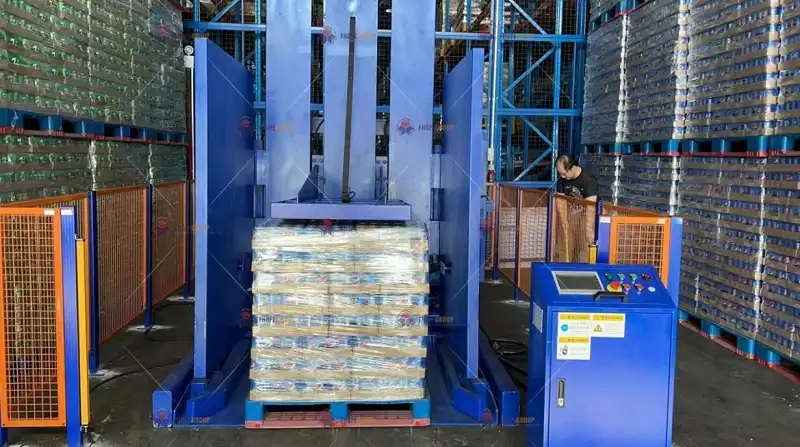
The successful implementation of a single-operator EoL system depends on the careful selection and integration of robust, proven hardware components. Each piece of equipment serves a specific function but is designed to operate as part of a larger, cohesive whole.
Automated Palletizing and Depalletizing Solutions
The heart of the automated EoL cell is the palletizer, which systematically arranges and stacks products onto a pallet. The choice of technology is dictated by factors such as required throughput, product type, and budget.
The Robotic Core
Modern palletizing is dominated by robotic solutions, which offer unparalleled flexibility and precision. Two main categories of robots are employed:
- Industrial Robots: These are the high-performance workhorses of the automation world. Robots from manufacturers like FANUC, KUKA, and ABB are engineered for high-speed, high-payload applications and are capable of sustaining demanding, 24/7 production schedules.9 For example, a FANUC M-410iB series robot can handle payloads up to 140 kg and palletize at rates of up to 44 cases per minute, making it ideal for high-volume industries like food and beverage.14 These systems are typically enclosed in safety caging to protect personnel from their rapid movements.15
- Collaborative Robots (Cobots): Cobots represent a more recent evolution in robotics, designed to operate safely in close proximity to human workers with minimal or no traditional safety guarding.16 They operate at lower speeds and handle lighter payloads (e.g., up to 60 lbs or 8-22 cases per minute) compared to their industrial counterparts.9 Their key advantages are a smaller footprint, easier programming, and faster deployment, making them an excellent choice for businesses taking their first steps into automation, for applications with space constraints, or where production lines need to be flexible and reconfigurable.17
End-of-Arm Tooling (EOAT): The Robot’s Hands
A robot is only as effective as its End-of-Arm Tooling (EOAT), the custom gripper or "hand" that interacts with the product. The design of the EOAT is critically important and is tailored to the specific product being handled. Common types include:
- Vacuum Grippers: These use suction cups to pick up sealed cases, cartons, and trays. They are highly versatile, and advanced versions can feature programmed zones to pick up multiple cases at once to form a complete layer.9
- Clamp or Fork Grippers: These are used for handling rows or bundles of products, such as shrink-wrapped packs of bottles. The tool slides under or clamps the sides of a pre-formed row of items.18
- Specialized Bag Grippers: For unstable products like bags of minerals, feed, or soil, a specialized tool is required that can securely cradle the bag from below and the sides to place it accurately on the pallet without spilling or deforming the product.19
- Custom EOAT: For unique product shapes or handling requirements, system integrators will design and fabricate a completely custom EOAT to ensure reliable performance.10
Upstream Integration: Case Erectors & Packers
The performance of a palletizing system is fundamentally dependent on the efficiency of the equipment that feeds it. A high-speed palletizing robot is of little value if it is constantly waiting for products to arrive. Therefore, a truly integrated system must automate the processes immediately upstream of the palletizer. This includes:
- Case Erectors: Machines that automatically form flat corrugated blanks into erected cases, sealing the bottom flaps with tape or glue.20
- Case Packers: After erection, cases are moved to a packing station where products are automatically loaded. This can be done via drop packing for sturdy items or with robotic pick-and-place systems for more delicate or complex arrangements.21
- Case Sealers: Once filled, the case is conveyed through a sealer that closes and seals the top flaps.20
Many vendors offer compact, "all-in-one" machines that combine case erecting, packing, and sealing into a single unit, saving floor space and simplifying integration.21 The critical consideration for any operations manager is to ensure that the throughput capacity of this entire upstream sequence is matched to or exceeds the capacity of the palletizer. A holistic line design approach is essential. Focusing solely on the impressive specifications of a palletizing robot without adequately sizing the case handling systems that feed it will inevitably create a bottleneck, starving the robot and capping the entire line’s output at the rate of the slowest machine. This is why partnering with a single-source system integrator who can analyze and synchronize the entire line, from primary packaging to final pallet wrapping, is often the most effective strategy for achieving optimal performance.9
Load Containment I: Automated Strapping Systems
Once a full pallet load has been assembled, it must be secured. Automated strapping systems provide the primary means of unitizing the load, preventing layers from shifting and ensuring the entire stack behaves as a single, stable unit during transport.
Vertical vs. Horizontal Strapping
A complete load-securing solution often involves both vertical and horizontal strapping, each serving a distinct purpose:
- Vertical Strapping: An automatic vertical strapping machine feeds straps from top to bottom, passing them through the pallet voids and securing the entire product stack directly to the pallet itself.5 This is fundamental for preventing the load from sliding off the pallet. Systems can be programmed to apply one, two, or more straps, and some feature a 90-degree turntable to apply straps in both directions (a 2×2 pattern) for maximum security.5
- Horizontal Strapping: A horizontal strapper applies bands around the perimeter of the product stack at various heights.5 This is crucial for stabilizing individual layers, preventing boxes from bulging or falling outwards, and maintaining the integrity of columnar stacks. The number and position of the horizontal straps can be configured based on the load’s characteristics.5
These machines are designed for integration into conveyor lines and can achieve high throughput, with some models capable of strapping up to 60 pallets per hour.5 They can use either Polyester (PET) or Polypropylene (PP) strapping material, with PET generally offering higher strength and tension retention for heavier loads.5
Advanced Strapping Features
To enhance product protection and load stability further, modern strapping systems can be equipped with several advanced modules:
- Pallet Packing Presses: For loads that are compressible (e.g., textiles, empty containers) or prone to settling, a pallet packing press is invaluable. This system incorporates a platen that descends and applies a controlled amount of pressure to the top of the load, compressing it before the straps are applied. This creates a denser, more stable pallet that is less likely to loosen during transit. These systems often combine pressing and strapping into a single, efficient production step.22
- Corner and Edge Protection Applicators: High strap tension, while necessary for stability, can crush the corners of corrugated cases, damaging the product within. To prevent this, automated corner board applicators can be integrated into the strapping line. These robotic or mechanical systems automatically place pre-formed cardboard or plastic edge protectors onto the corners of the load just before the straps are applied, distributing the tension and protecting the product.5
- Load Compacting Systems: As an accessory to horizontal strappers, a compacting system uses side plates to gently squeeze and align the load, ensuring all boxes are squared up before the strap is applied. This guarantees optimal strap placement and a tighter, more secure bundle.5
Load Containment II: Automated Wrapping and Hooding Technologies
After strapping provides unitization, a final layer of containment is required to protect the load from environmental factors like dust, dirt, and moisture, and to provide a final layer of security.
Stretch Wrapping
This is the most widely used method for final load containment, involving the application of a stretchable plastic film.
- Turntable Automatic Stretch Wrappers: In this configuration, the pallet is conveyed onto a rotating platform. As the turntable spins the load, a film carriage mast moves up and down, dispensing the stretch film to cover the pallet from bottom to top.6 These systems are efficient and have a relatively small footprint, making them ideal for stable, uniform loads.
- Rotary Arm Automatic Stretch Wrappers: For loads that are very light, tall, heavy, or inherently unstable, spinning them on a turntable can cause them to shift or collapse. The solution is a rotary arm wrapper. Here, the pallet remains stationary on the conveyor while an arm holding the film carriage rotates around the load.6 This method ensures the load remains completely stable throughout the wrapping process.
Both types of automatic wrappers feature automatic film clamping and cutting, powered pre-stretch heads to optimize film usage, and programmable wrap patterns that can be selected via the HMI to suit different load types.6
Stretch Hood Systems
A highly effective alternative to stretch wrapping, a stretch hooder uses a continuous gusseted tube of film. The machine pulls a length of film from the roll, stretches it open using a set of grippers, lowers it over the stationary pallet, and then releases it. The film’s elastic recovery causes it to shrink tightly around the load.7 The primary advantages of stretch hooding are:
- Superior Protection: It provides complete, five-sided protection (top and four sides), creating a waterproof and dust-proof seal that is ideal for outdoor storage.7
- High Load Stability: The vertical and horizontal holding forces are excellent, often superior to stretch wrap.
- High Throughput: These systems are very fast, capable of processing up to 120 pallets per hour.7
- Marketing: The film is optically clear, allowing for excellent visibility of the product and any branding underneath.
- Reduced Waste: Stretch hooding can often use less film material per pallet compared to stretch wrapping.23
Shrink Hood Systems
Similar in concept to stretch hooding, a shrink hood system places a pre-made or machine-made bag of film over the pallet. The pallet is then passed through a heat tunnel or frame, which causes the film to shrink and conform tightly to the load.23 It also offers excellent weather resistance and load stability and is particularly adept at handling pallets with diverse or irregular dimensions.23
The choice between these technologies is a critical strategic decision, involving a trade-off between capital cost, operational cost (film consumption), required throughput, and the necessary level of product protection.
| Technology | Throughput (Pallets/Hour) | Load Protection | Film Consumption (Relative) | Load Stability | Typical Capital Cost (Relative) |
|---|---|---|---|---|---|
| Turntable Stretch Wrap | 30 – 50 | Dust/Moisture Resistance | Medium | Good | Low |
| Rotary Arm Stretch Wrap | 35 – 60 | Dust/Moisture Resistance | Medium | Very Good (for unstable loads) | Medium |
| Stretch Hood | 60 – 120+ | 5-Sided Waterproof/UV | Low-Medium | Excellent | High |
| Shrink Hood | up to 60 | 5-Sided Waterproof/UV | High | Excellent | High |
Pallet Management: Dispensers, Changers, and Inverters
Effective management of the pallets themselves is a crucial, though sometimes overlooked, aspect of a fully automated line.
Automated Pallet Dispensers
For any automated palletizing line, an automatic pallet dispenser is a non-negotiable component. This machine holds a stack of 10-15 empty pallets and automatically dispenses them one by one onto the infeed conveyor that feeds the robotic palletizing cell.10 This simple but essential device eliminates the need for an operator to manually handle and place heavy, awkward pallets, a task that is both inefficient and a common source of back injuries. It ensures the palletizing robot has a consistent and reliable supply of empty pallets, enabling continuous operation.19
Pallet Changers and Pallet Inverters
It is vital to distinguish between the universal need for a pallet dispenser and the highly specialized need for a pallet changer or inverter. While the user query specifically mentions "pallet changing," this function is not required for most standard packaging lines. A pallet changer is a standalone machine designed to transfer a fully stacked load of products from one pallet to another.4 The process typically involves clamping the load securely on its sides and top, then rotating the entire load and pallet assembly by 180 degrees (inversion).24 With the load now upside down, the original pallet (which is now on top) can be easily removed. A new pallet is then placed on the load, and the assembly is rotated back to its original orientation.
This technology is not part of the standard palletize-strap-wrap workflow but is instead used to solve specific logistical or process challenges, such as:
- Hygiene Compliance: In the food, beverage, and pharmaceutical industries, products often must be moved from standard wooden warehouse pallets to more hygienic and cleanable plastic or aluminum pallets before entering a production or cleanroom environment.4
- Shipping and Logistics Requirements: A customer or a pallet pooling service like CHEP may mandate that goods be shipped on their specific rental pallets. A pallet changer allows for the transfer of finished goods from in-house pallets to these required shipping pallets just before dispatch.4
- Damaged Pallet Recovery: If a pallet under a fully stacked and wrapped load is found to be broken, a pallet inverter provides a way to replace it without having to manually unstack and restack hundreds of cases, saving immense time and labor.25
The inclusion of a pallet changer or inverter adds significant cost, complexity, and floor space to an EoL system. Therefore, a key step in the planning process is to critically assess whether the operation truly requires this capability. For the vast majority of applications, an automated pallet dispenser at the beginning of the line is the correct and sufficient solution. Misunderstanding this distinction can lead to significant over-specification and unnecessary capital expenditure.
Intralogistics: The Role of Conveyors, AGVs, and AMRs
The final piece of the automated puzzle is the transport of the finished, secured pallet from the packaging line to the warehouse.
Conveyor Systems
Conveyors are the circulatory system of the automated line, the arteries that ensure a smooth and continuous flow of materials between each processing station.7 A typical EoL system will use a network of conveyors for several purposes: case conveyors to bring products to the palletizer, pallet conveyors to move empty and full pallets between the palletizer, strapper, and wrapper, and accumulation conveyors at the end of the line to stage finished pallets for pickup.6 The design, speed, and logic of the conveyor system are critical for preventing jams and bottlenecks and must be carefully engineered by the system integrator.
Automated Guided Vehicles (AGVs) & Autonomous Mobile Robots (AMRs)
Once a pallet exits the final wrapping station and is staged on an output conveyor, the automated "warehousing" function takes over. This is handled by a fleet of mobile robots.
- Function: An AGV or AMR is automatically dispatched by a fleet management system to the end of the packaging line. It picks up the completed pallet and transports it to a predefined destination within the facility, such as a bulk storage area, an input station for an Automated Storage and Retrieval System (ASRS), or a shipping dock.8 This eliminates the need for forklift traffic in the production area, significantly improving safety and efficiency.
- AGV vs. AMR:
- Automated Guided Vehicles (AGVs) are the more traditional technology. They navigate by following fixed physical guides like magnetic tape on the floor, wires embedded in the concrete, or by using laser triangulation off of fixed reflectors.26 They are extremely reliable and well-suited for simple, repetitive, A-to-B transport tasks in a structured environment. If an AGV encounters an obstacle in its path, it will typically stop and wait for it to be cleared.27
- Autonomous Mobile Robots (AMRs) represent a more advanced and flexible technology. Instead of following fixed paths, AMRs use technologies like SLAM (Simultaneous Localization and Mapping) and LiDAR to build a map of the facility and navigate dynamically, much like a self-driving car.27 If an AMR encounters an obstacle, it can intelligently and safely navigate around it.28
- Integration: The key to using these mobile robots effectively is their integration with the plant’s overarching software systems. The end-of-line control system must signal to the robot fleet manager that a pallet is ready for pickup. The fleet manager, which may in turn be integrated with a Warehouse Management System (WMS) or Manufacturing Execution System (MES), then assigns the "mission" to the nearest available robot, telling it where to go, what to pick up, and where to take it.26
The Central Nervous System: Integration, Control, and Data
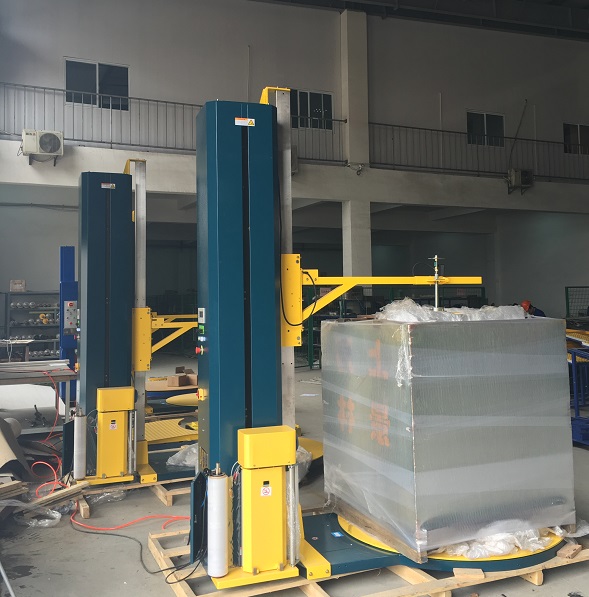
The sophisticated hardware components described above are merely isolated machines until they are unified by a robust control architecture. This "central nervous system" is what transforms a collection of equipment into a single, cohesive, and intelligent system that can be managed by one operator.
The PLC and Sensor Backbone
At the foundation of industrial automation lies the combination of Programmable Logic Controllers (PLCs) and a comprehensive network of sensors.
- Programmable Logic Controllers (PLCs): A PLC is a ruggedized industrial computer that serves as the localized brain for a machine or a small cell of machines.29 It executes a pre-programmed set of instructions (ladder logic) with high speed and reliability. For example, the PLC controlling the stretch wrapper receives a signal that a pallet has arrived, and it then executes the sequence to lower the clamp, start the rotation, move the film mast up and down for a set number of rotations, and then cut the film.30 Each major component in the EoL line—the palletizer, strapper, wrapper, and conveyors—will have its own PLC or be controlled by a centralized one.29
- The Sensor Network: The System’s Senses: PLCs are blind and deaf without the input they receive from a vast array of sensors, which act as the system’s eyes, ears, and sense of touch. These sensors provide the real-time data needed for the PLC to make decisions.29 The sensor network in an integrated EoL line includes:
- Photoelectric and Proximity Sensors: These are the most common sensors, used to detect the presence or absence of an object. They confirm that a box has reached the end of a conveyor, a pallet is in the correct position for wrapping, or a safety gate is closed.31
- Vision Systems and Barcode Readers: More advanced sensors that provide richer data. A barcode reader can scan a case or pallet label to identify the product and tell the control system which "recipe" to use for palletizing and wrapping.32 A vision system can perform quality checks, such as verifying label placement or confirming that a case flap is properly sealed.33
- Load Cells: These sensors measure weight and can be integrated into conveyor sections to perform quality control checks, ensuring that cases or pallets are within their specified weight tolerance.31
- Encoders and Resolvers: These devices are attached to motors and rotating shafts to provide precise feedback on speed, direction, and position, which is critical for the coordinated movements of robots and conveyors.
The Human-Machine Interface (HMI): A Single Pane of Glass
The Human-Machine Interface (HMI) is the critical link between the single operator and the entire automated system. It is the command center that consolidates control and monitoring of all the integrated machines into one centralized location.11 Gone are the days of walking between multiple disparate control panels. Modern HMIs are typically large (10-inch or larger), high-resolution, capacitive multi-touch screens housed in robust, IP65-rated enclosures to withstand the industrial environment.11
The HMI is designed with usability as a primary focus, featuring intuitive, graphical interfaces with meaningful icons and smooth navigation, making it easy for new users to learn and operate.11 Its core functions enable the operator to manage the entire line efficiently:
- System Monitoring and Visualization: The main screen of the HMI typically displays a graphical representation of the entire EoL line. It shows the real-time status of each machine (e.g., running, idle, faulted, offline) and the flow of products through the system. This allows the operator to understand the state of the entire process at a glance.11
- Recipe Management: This is perhaps the most powerful function for operational flexibility. A "recipe" is a set of pre-programmed parameters for a specific product or SKU. For example, a recipe might include the case dimensions, the robotic stacking pattern, the number and tension of straps, and the stretch wrap rotation count.34 When production needs to switch from Product A to Product B, the operator simply selects the corresponding recipe on the HMI, and all the machines in the line automatically adjust their settings. This allows for rapid changeovers with minimal downtime, a feat impossible in a manual or semi-automated environment.9
- Alarm and Diagnostic Management: When a problem occurs—such as a film break on the wrapper, a strap jam, or a blocked sensor—the system doesn’t just stop. The HMI immediately displays a clear, descriptive alarm message, pinpointing the exact location of the fault and often providing step-by-step instructions or diagrams to help the operator resolve the issue quickly.11 This drastically reduces troubleshooting time and minimizes downtime.
- Data Visualization and Production Reporting: The HMI serves as a window into the line’s performance. It can display key performance indicators (KPIs) in real-time, such as throughput in pallets per hour, Overall Equipment Effectiveness (OEE), cycle times, and material consumption rates. This data can be logged and exported for further analysis by engineering and management teams.11
Achieving True Integration: Connectivity, Protocols, and Industry 4.0
True integration goes beyond simply placing machines next to each other on a conveyor. It requires a hierarchical control structure and a common communication language that allows all components to work in concert.
- The Integration Hierarchy: The control system is layered. At the base are the individual machine PLCs. These PLCs are networked together and communicate with a higher-level controller, which could be a master PLC, an industrial PC, or a SCADA (Supervisory Control and Data Acquisition) system. This master controller orchestrates the handoffs between machines. For example, it tells the strapper that the palletizer has just completed a load and signals the conveyor to move the pallet forward. This central system is also the brain that connects the physical machinery on the plant floor (Operational Technology, or OT) with the business-level software systems (Information Technology, or IT) like the MES or WMS.34
- Communication Protocols: For machines and controllers from different vendors to communicate seamlessly, they must speak a common language. This is achieved through standard industrial communication protocols. Modern systems predominantly use Ethernet-based protocols like EtherNet/IP, PROFINET, and EtherCAT, which offer high-speed, reliable data exchange.34 A key protocol for vertical integration (from machine to enterprise level) is OPC-UA (Open Platform Communications Unified Architecture), which provides a secure and standardized way to share data between the plant floor and higher-level software systems.11
- Industry 4.0 and Data-Driven Operations: A fully integrated and connected EoL line is, by its nature, an Industry 4.0 system.7 It is a cyber-physical system that generates a massive stream of valuable data. This data is no longer locked away in individual machines but is accessible across the network, enabling a host of advanced capabilities:
- Predictive Maintenance: By mounting sensors to monitor machine parameters like vibration, motor temperature, and current draw, it’s possible to use data analytics to predict when a component is likely to fail. This allows maintenance to be scheduled proactively before an unexpected breakdown occurs, maximizing uptime.33
- Process Optimization: Analyzing historical production data can reveal subtle inefficiencies and opportunities for improvement. For instance, data might show that a specific wrap pattern is correlated with a higher rate of film breaks, prompting a change in the recipe.
- Enhanced Traceability: The system creates a complete digital birth certificate for every pallet. By linking barcode scans and sensor data at each stage, a full history of the pallet’s journey through the EoL process is recorded, which is invaluable for quality control, regulatory compliance, and handling any potential recalls.35
The Evolved Role of the Operator: From Laborer to System Supervisor

The implementation of a fully automated, single-operator EoL system fundamentally redefines the nature of work on the packaging floor. It marks a decisive shift away from physically demanding manual labor toward a more cognitive, technology-focused supervisory role.
A New Paradigm of Work
In a traditional packaging environment, the operator’s value is derived from their physical output—their ability to lift, stack, push, and pull. The work is repetitive, strenuous, and carries a significant risk of musculoskeletal injuries from tasks like bending over to strap pallets or manually lifting heavy cases.3 This environment often leads to high employee turnover, fatigue-related errors, and limitations on throughput based on human endurance.
In the automated ecosystem, this paradigm is inverted. The system is designed to eliminate these physically taxing and hazardous tasks.1 The value of the single operator is no longer in their physical strength but in their ability to manage and oversee the technology. The role becomes that of a system supervisor or cell technician, whose primary function is to ensure the continuous, efficient, and high-quality operation of the automated line.13 This shift not only improves workplace safety and ergonomics but also creates a more engaging and technically skilled position, which can lead to higher job satisfaction and employee retention.
Key Responsibilities in an Automated Environment
The daily responsibilities of the single operator are centered around system management, quality assurance, and proactive intervention, rather than direct manual labor. Key tasks include:
- System Start-up and Shutdown: Performing pre-flight checks at the beginning of a shift, ensuring all safety guards are in place, and initiating the automated production sequence via the HMI. The operator also follows proper shutdown procedures at the end of the day.
- Production Monitoring: The operator’s primary focus during the run is on the HMI. They actively monitor the graphical overview of the line, keeping an eye on production counts, cycle times, and the status of each machine to ensure everything is running according to plan and meeting production targets.13
- Consumable Replenishment: This is the most significant remaining manual task. The operator is responsible for keeping the machines supplied with the necessary materials. This includes loading new mega-rolls of stretch film onto the wrapper, replacing spools of strapping, refilling the magazines for labels and corner boards, and loading stacks of empty pallets into the dispenser and flat case blanks into the case erector.13 These tasks are designed to be quick and ergonomic.
- Quality Control Checks: While the system has automated inspection capabilities, the operator serves as the final human check. They will periodically inspect finished pallets as they exit the line to visually confirm package integrity, label accuracy, and overall load stability, ensuring that quality standards are consistently met.1
- First-Level Troubleshooting and Fault Recovery: When the HMI indicates a minor fault, the operator is the first line of defense. Using the diagnostic information provided, they are trained to resolve simple issues themselves, such as clearing a jammed case from a conveyor, re-threading a broken film roll, or resetting a sensor.13
- Coordination and Communication: The operator acts as a communication hub. They liaise with the maintenance department when a fault requires more advanced technical intervention, and they coordinate with the warehouse or logistics team to ensure a smooth flow of finished goods away from the line.
Essential Skills, Training, and Safety Protocols
The transition to a supervisory role requires a corresponding shift in the operator’s skillset.
- Required Skillset: The ideal candidate for this role possesses a strong mechanical aptitude, basic computer literacy, and excellent attention to detail.1 They must be methodical problem-solvers who can remain calm under pressure and follow procedural instructions precisely. The emphasis is on cognitive ability rather than physical prowess.36
- Training is Non-Negotiable: The success of a highly automated system is inextricably linked to the quality of the operator training. It is a critical error to invest millions in capital equipment without investing adequately in the people who will run it. The system integrator or OEM must provide comprehensive training as part of the commissioning process.2 This training should cover:
- Detailed operation of the HMI, including recipe management and system monitoring.
- The function and purpose of every machine in the line.
- Standard operating procedures for startup, shutdown, and changeovers.
- Procedures for all consumable replenishment tasks.
- First-level fault diagnosis and recovery procedures for common alerts.37
- Safety Systems and Protocols: The operator works within a robust safety infrastructure designed to protect them from the powerful machinery. This multi-layered system includes:
- Physical Guarding: Safety fencing that creates a perimeter around the robotic cells, preventing accidental entry into the machine’s operating envelope.15
- Light Curtains: Invisible infrared beams that guard openings in the fencing. If an operator breaks the beam (e.g., by reaching into the cell), the system immediately enters a safe-stop mode.14
- Interlocked Gates: Access doors in the safety fencing are equipped with interlocks. Opening a gate cuts power to the machinery inside, ensuring it cannot operate while a person is present.
- Emergency Stop Buttons (E-Stops): E-stop buttons are placed at key points around the line, allowing the operator to immediately halt all motion in an emergency.
The operator must be thoroughly trained on all safety features and protocols, understanding what each system does and how to work safely around the automated equipment.
A Strategic Roadmap for Implementation
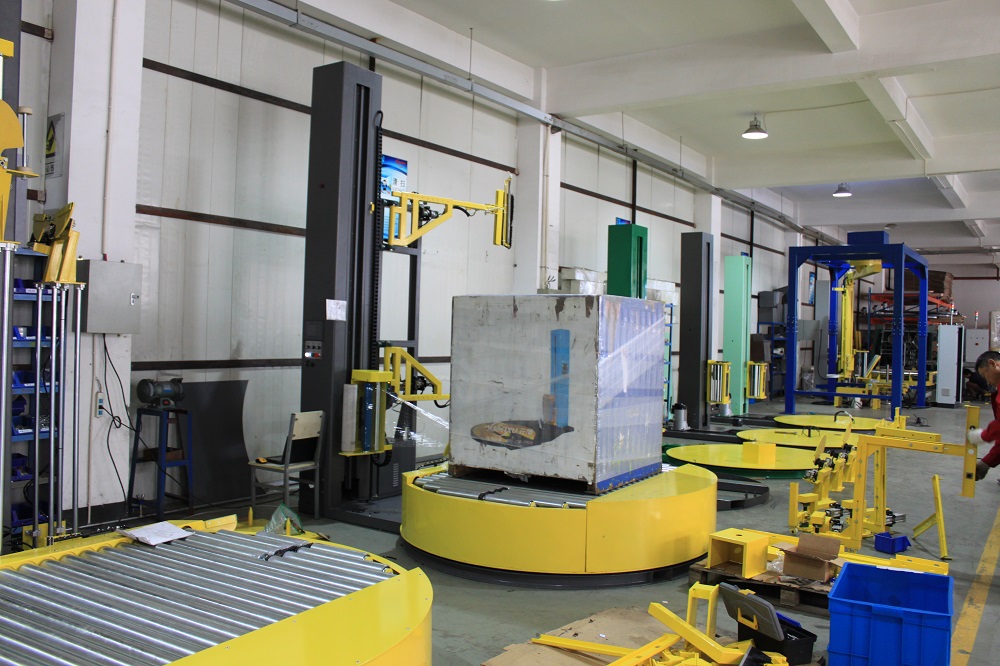
Deploying a single-operator, integrated EoL system is a major capital project that requires meticulous planning and strategic execution. A phased approach, from initial concept to final commissioning, is essential for success.
Phase 1: Defining Requirements and Auditing Operations
Before any vendor is contacted, a thorough internal audit must be conducted to define the project’s requirements and establish a baseline for performance. This is the most critical phase, as the data gathered here will inform every subsequent decision. This process, often conducted with the help of a potential integration partner, involves a detailed on-site review of the current operation.8 Key data points to document include:
- Product and Packaging Specifications: A complete catalog of all products to be handled, including their dimensions (L x W x H), weight, fragility, and packaging type (e.g., RSC cases, trays, bags).
- Pallet and Load Configurations: The types and sizes of pallets used (e.g., GMA, CHEP), and the specific stacking patterns required for each product.
- Throughput Requirements: The target production rate, measured in cases per minute and/or finished pallets per hour. This must account for current demand as well as projected future growth.
- Facility and Layout Constraints: A detailed survey of the available floor space, ceiling heights, column spacing, and the location of existing utilities. This will determine the physical feasibility of different equipment layouts.2
- Operational Baseline: A clear accounting of current labor costs associated with the EoL process, throughput rates, material waste, and, critically, the frequency and cost of workplace injuries related to manual handling. This data is essential for building the ROI justification.2
Phase 2: Navigating the Vendor Landscape and Selecting Partners
With a clear set of requirements, the next step is to engage with the technology providers. The market for automation is complex, comprising both specialized equipment manufacturers and broad-based system integrators.
OEMs vs. System Integrators
Understanding the distinction between these two types of vendors is crucial for selecting the right partner:
- Original Equipment Manufacturers (OEMs): These companies are experts in designing and building specific types of machines. For example, Mosca and Signode are leaders in strapping technology 22, FANUC and KUKA are leaders in industrial robotics 10, and Robopac is a leader in stretch wrapping.38 An organization could choose to buy the "best-in-class" machine from several different OEMs.
- System Integrators: These firms specialize in the engineering, design, and project management required to combine equipment from multiple OEMs into a single, functional, and turnkey production line.39 Companies like BW Integrated Systems, Kaufman Engineered Systems, and CRG Automation take on the responsibility for the entire project—from initial design and simulation to programming the control systems, managing the installation, and commissioning the final line.6
For a complex, multi-function line involving palletizing, strapping, wrapping, and conveying, partnering with an experienced system integrator is often the most effective and lowest-risk approach. The integrator acts as a single point of responsibility, ensuring that all components are properly sized, synchronized, and programmed to work together, thus avoiding the significant technical challenges of trying to make disparate systems communicate.2
To aid in this selection process, the following matrix provides an overview of key vendors across the different technology categories.
| Function | Key Vendors |
|---|---|
| Robotic Palletizing | FANUC, KUKA, ABB, Combi, Motion Controls Robotics, DEVELOP LLC 3 |
| Automated Strapping | Mosca, Signode, Innova Maquinaria, Handle-It 5 |
| Wrapping & Hooding | Kaufman, Innova Maquinaria, Robopac, Arpac 6 |
| AGVs / AMRs | Signode (Simplimatic), MESH Automation, Locus Robotics, Dematic 8 |
| ASRS / Warehouse Automation | Dematic, Honeywell Intelligrated, SSI Schaefer, KNAPP, WITRON, Swisslog 40 |
| Full-Line System Integration | BW Integrated Systems, Kaufman Engineered Systems, Signode, CRG Automation, nVenia 6 |
Phase 3: Overcoming Implementation Challenges
The path to full automation is not without its obstacles. Proactively identifying and planning for these challenges is key to a smooth and successful implementation.
- High Initial Investment: The upfront capital cost for a fully integrated automated line is significant.2 Justifying this expenditure requires a comprehensive Return on Investment (ROI) analysis that goes beyond simple labor savings. The calculation must include the long-term financial benefits of increased throughput, reduced product damage, lower material waste, elimination of ergonomic injury costs (worker’s compensation, insurance), and improved customer satisfaction due to higher quality packaging.2
- Technical Integration: This is often the greatest technical hurdle. Ensuring that the robot from Vendor A, the strapper from Vendor B, and the wrapper from Vendor C can all communicate flawlessly requires deep expertise in control systems and industrial networking.2 This is where the value of a single-source system integrator becomes most apparent. They take ownership of this challenge, designing the control architecture and ensuring all machines speak the same language.41
- Maintenance and Downtime: Automated systems, while reliable, are more complex than manual processes and require a different approach to maintenance. A robust preventive maintenance program is essential to maximize uptime and the longevity of the equipment.2 The implementation plan must include a strategy for stocking critical spare parts and training the in-house maintenance team or securing a service contract with the integrator.
- Workforce Adaptation and Training: The human factor is a crucial element of success. Employees may be resistant to change or feel intimidated by new technology.2 The best way to mitigate this is through early and transparent communication. Involve the operators and maintenance staff in the design and selection process. Emphasize that the goal of automation is to eliminate dangerous and monotonous work and create safer, more highly skilled jobs. As noted previously, comprehensive training is not an option; it is a requirement for a successful launch and sustained operation.41
Concluding Analysis and Future Outlook

Summary of Findings
The ambition to perform palletizing, strapping, packing, and automated warehousing with a single operator is not only feasible but represents the logical evolution of modern end-of-line operations. This analysis has established that this model is achievable through the strategic integration of several key technologies: robotic palletizers, automated strapping and wrapping systems, and autonomous mobile robots for material transport.
The success of such a system is contingent on three core principles. First, the selection of robust, industry-proven hardware for each discrete function. Second, and most critically, the deep integration of these hardware components through a unified control system, orchestrated by PLCs and managed by the operator via a centralized HMI. This transforms a collection of machines into a single, cohesive production cell. Third, the redefinition of the human role. The operator is no longer a source of manual labor but is elevated to the position of a system supervisor, whose cognitive skills in monitoring, troubleshooting, and quality assurance are paramount.
Implementation is a significant undertaking that requires a rigorous strategic approach. It begins with a detailed internal audit to define requirements, proceeds through a careful vendor selection process where the choice between specialized OEMs and a turnkey system integrator is critical, and must proactively address the challenges of capital investment, technical integration, and workforce adaptation. When executed correctly, the result is a quantum leap in efficiency, safety, and consistency.
The Future is Smarter
The trajectory of EoL automation is moving beyond simple, pre-programmed task execution toward systems that are increasingly intelligent and adaptive. The foundation of connectivity and data collection being laid today is paving the way for the next generation of smart packaging lines. Emerging trends that will further enhance these systems include:
- Artificial Intelligence (AI) and Machine Learning: The vast amounts of data generated by the sensor networks on these lines will be leveraged by AI algorithms. This will enable more sophisticated predictive maintenance, where the system can not only predict a failure but also diagnose its root cause. AI will also facilitate self-optimizing line performance, where the system can learn over time and automatically adjust parameters—like conveyor speeds or robot motions—to maximize throughput and minimize energy consumption.42
- Digital Twins: Before a single piece of hardware is ordered, system integrators will create a complete, physics-based virtual model—a digital twin—of the entire EoL line. This allows for extensive simulation to validate the design, optimize the layout, and de-bug the control logic in a virtual environment. It can also be used as a powerful tool to train operators, allowing them to experience and learn how to handle various fault scenarios in a safe, simulated setting before ever touching the real equipment.
The future of the single-operator EoL ecosystem lies in systems that are not just automated, but truly autonomous and intelligent, capable of adapting, learning, and collaborating with their human supervisors to achieve unprecedented levels of productivity and quality.
Works cited
-
Packaging Operator – Jobs at Bunge, accessed June 22, 2025, https://jobs.bunge.com/job/Oakville-Packaging-Operator-ON-L6L-5N3/1211417001/
-
Challenges in Automated Packaging Line Implementation – Synchropack, accessed June 22, 2025, https://synchropack.com/en/automation/common-challenges-in-implementing-automated-packaging-lines/
-
Robotic Palletizing & Packaging Systems | DEVELOP LLC, accessed June 22, 2025, https://develop-llc.com/automation-services/agnostic-robotic-integrations/packaging-palletizing/
-
Pallet Changers – Cherry’s Industrial Equipment, accessed June 22, 2025, https://cherrysind.com/pallet-changers
-
Automatic Pallet Strapping Machines | Maximum Hold for your loads – Innova Maquinaria, accessed June 22, 2025, https://en.innovamaquinaria.com/strapping/
-
KForce R20 Stretch Wrapping – Automated End of Line Manufacturer, accessed June 22, 2025, https://www.kaufmanengsys.com/robotics/kforce-r35c-stretch-wrapping
-
END OF LINE | Your Custom Packaging Line by Innova, accessed June 22, 2025, https://en.innovamaquinaria.com/stretch-hood-line/
-
Integrated Lines – End of Line Packaging Solutions | Signode, accessed June 22, 2025, https://www.signode.com/systemsandsolutions/automation/
-
Robotic Palletizer | Palletizing Robot | Combi Packaging Equipment, accessed June 22, 2025, https://combi.com/equipment/robotic-palletizing-systems
-
Automated Palletizing Solutions – Boost Efficiency – Linc Systems, accessed June 22, 2025, https://www.lincsystems.com/automated-equipment/automatic-palletizing
-
HMI / User interface – Packaging machine – Christ Packing Systems, accessed June 22, 2025, https://www.christ-ps.com/en/technology/hmi
-
IPS – Integrated Packaging Solution – Packaging – Machines – Solutions – Kraft Group, accessed June 22, 2025, https://www.kraft-group.com/en/solutions/machines/packaging/ips-integrated-packaging-solution/
-
5 Packing Line Operator Job Description Templates and Examples – Himalayas.app, accessed June 22, 2025, https://himalayas.app/job-descriptions/packing-line-operator
-
Two Packaging Lines – One Palletizing Station – Motion Controls Robotics, accessed June 22, 2025, https://motioncontrolsrobotics.com/resources/case-study/two-packaging-lines-one-palletizing-station/
-
End Of Line Packaging Design Solutions – Automatic Palletizer & Robots Manufacturer, accessed June 22, 2025, https://conveyor-automation.com/robotics
-
Productive Packaging Solutions: Cobots & Strapping Machines – EAM-Mosca, accessed June 22, 2025, https://www.eammosca.com/blog/productive-packaging-solutions-cobots-strapping-machines/
-
Robotic Packaging Machinery by ONExia | Boost Efficiency, accessed June 22, 2025, https://onexia.com/packaging/
-
Packaging & Palletizing – STM Pack, accessed June 22, 2025, https://stm-pack.com/machines-categories/palletizing/
-
Packaging and Palletizing Line for Bags of Supplements – Tinsley Company, accessed June 22, 2025, https://www.tinsleycompany.com/packaging-and-robotic-palletizer-system-for-livestock-minerals-and-supplements/
-
Case Packing & Palletizing Machines | End-of-Line Solutions – Paxiom Group, accessed June 22, 2025, https://www.paxiom.com/end-of-line-case-packing-and-palletizing-machines/
-
Robotic Case Palletizing Machines | End-of-Line Solutions – Paxiom Group, accessed June 22, 2025, https://www.paxiom.com/end-of-line-palletizing-solutions/
-
Strapping Machines – Mosca GmbH, accessed June 22, 2025, https://www.mosca.com/en/Produkte/Umreifungsmaschinen
-
Powering Quebec’s end-of-line Packaging | Link Pack, accessed June 22, 2025, https://link-pack.com/powering-quebecs-end-of-line-packaging/
-
More Pallet Inverters Canada, accessed June 22, 2025, https://palletinverter.ca/more_palletinverters.htm
-
Stationary pallet inverter consists of a sturdy frame equipped with hydraulic or mechanical mechanisms designed to securely hold and manipulate pallets., accessed June 22, 2025, https://www.huamaiattachments.com/stationary-pallet-inverter-consists-of-a-sturdy-frame-equipped-with-hydraulic-or-mechanical-mechanisms-designed-to-securely-hold-and-manipulate-pallets/
-
AGVs and AMRs Guide – Navigating the Future of Material Handling | Industrial Kinetics, accessed June 22, 2025, https://www.iki.com/blog/2024/02/26/agvs-and-amrs/
-
Autonomous Mobile Robots – AMRs and AGVs – Mesh Automation, accessed June 22, 2025, https://meshautomationinc.com/autonomous-mobile-robots/
-
Boosting Productivity with AGVs in Modern Manufacturing – ATS Industrial Automation, accessed June 22, 2025, https://atsindustrialautomation.com/blog-posts/boosting-productivity-with-agvs-in-modern-manufacturing/
-
Review on Implementation of Automatic Packing Machine System based on PLC – BiblioMed, accessed June 22, 2025, https://www.bibliomed.org/fulltextpdf.php?mno=197217
-
Integrating PLCs into Packaging Systems – InkJet, Inc., accessed June 22, 2025, https://inkjetinc.com/blogs/default-blog/integrating-plcs-into-packaging-systems
-
An overview of the use of PLC in food packaging machines – ResearchGate, accessed June 22, 2025, https://www.researchgate.net/publication/377530054_An_overview_of_the_use_of_PLC_in_food_packaging_machines
-
Automated Palletizing – CRG Automation, accessed June 22, 2025, https://crgautomation.com/automated-packaging-solutions/palletizer
-
Automation of Product Packaging: Ensuring Perfect Packaging Every Time, accessed June 22, 2025, https://blog.logicbus.com/automation-of-product-packaging-ensuring-perfect-packaging-every-time/
-
HMIs get Smarter to Improve User Experience with Packaging Machines, accessed June 22, 2025, https://www.eliter-packaging.com/newsroom/smart-hmi-packaging-machines.html
-
End-of-Line Packaging Automation Services – Force Design, Inc., accessed June 22, 2025, https://forcedesign.biz/services/end-of-line-packaging-automation/
-
Packaging Operator Job Description Template – HRBLADE, accessed June 22, 2025, https://hrblade.com/job-descriptions/packaging-operator
-
The Challenges of Packaging Automation – InkJet, Inc., accessed June 22, 2025, https://inkjetinc.com/blogs/default-blog/the-challenges-of-packaging-automation
-
Navigating Supply Chain Challenges With Advanced Packaging – Robopac USA, accessed June 22, 2025, https://robopacusa.com/navigating-supply-chain-challenges-with-advanced-packaging/
-
Packaging Line Optimization – BW Integrated Systems, accessed June 22, 2025, https://www.bwintegratedsystems.com/integrated-packaging-systems
-
30 Warehouse Automation Companies [Names, Locations, Offerings] – Conger Industries Inc. – Wisconsin’s Material Handling Experts, accessed June 22, 2025, https://www.conger.com/warehouse-automation-companies/
-
Navigating automation in packaging: challenges & solutions, accessed June 22, 2025, https://www.packaging-gateway.com/features/navigating-automation-in-packaging-challenges-solutions/
-
2025 Guide: Top 10 Global Leaders in Packaging Automation Solution Market – Extrapolate, accessed June 22, 2025, https://www.extrapolate.com/blog/10-players-packaging-automation-solution-market


